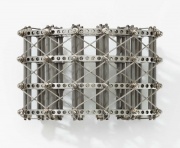Niobium
Jump to navigation
Jump to search
Description
A gray, corrosion-resistant metallic element originally named columbium. Niobium occurs in nature with Tantalum in the minerals columbite, pyrochlore, and tantalite. It was first discovered in 1801 by Charles Hatchett but not isolated until 1864 by Blomstrand. Niobium is found in deposits in Nigeria, Zaire, Brazil, Australia, Canada, and the United States. It is soft, ductile, and malleable and looks very similar to Platinum when polished. Niobium becomes a superconductor below 7 degrees Kelvin. It is most often used as an alloying material in Steel to stabilize the Carbon.
Synonyms and Related Terms
Nb; columbium; Niob (Deut., Sven.); niobio (It., Esp.); Nióbio (Port.)
Risks
- Flammable solid.
- Pyrophoric.
- Contact and ingestion causes severe irritation.
- Fisher Scientific: MSDS
Physical and Chemical Properties
Fuses with alkali hydroxides. Insoluble in acids at room temperature.
| Composition | Nb (atomic no. 41) |
|---|---|
| CAS | 7440-03-1 |
| Mohs Hardness | 6.0 |
| Melting Point | 2468 C |
| Density | 8.57 g/ml |
| Molecular Weight | atomic wt = 92.9064 |
| Boiling Point | 4927 C |
Resources and Citations
- Van Nostrand's Scientific Encyclopedia, Douglas M. Considine (ed.), Van Nostrand Reinhold, New York, 1976
- Random House, Webster's Encyclopedic Unabridged Dictionary of the English Language, Grammercy Book, New York, 1997
- The American Heritage Dictionary or Encarta, via Microsoft Bookshelf 98, Microsoft Corp., 1998
- Chemical & Engineering News, American Chemical Society, Washington DC, 81 (36) , Sept. 8, 2003 Comment: Pamela Zurer, p. 106: discovered by Hatchett in 1801
- Richard S. Lewis, Hawley's Condensed Chemical Dictionary, Van Nostrand Reinhold, New York, 10th ed., 1993
- The Merck Index, Martha Windholz (ed.), Merck Research Labs, Rahway NJ, 10th edition, 1983 Comment: entry 6648; discovered by Hatchett in 1801and isolated by Blomstrand in 1866
- Web Elements at http://www.webelements.com/webelements/elements/text/Nb/hist.html gives discovered by Hatchett in 1801 and isolated by Blomstrand in 1864
